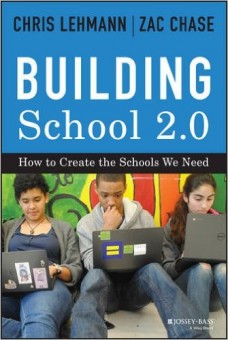How We Can Create the Schools We Need
Building School 2.0: How to Create the Schools We Need
By Chris Lehmann and Zac Chase
(Jossey-Bass, 2015 – Learn more)

“When we treat our classes as lenses on the world, not walled-off silos, we allow students to make connections to other ideas in a way that will allow them to connect idea to idea, though to thought, in ways that can be never-ending.” (Chase/Lehmann, page 231)
I had to resist the urge to dog-ear the heck out of this new book by Chris Lehmann and Zac Chase. It’s not that I didn’t want to be able to go back, time and again, to read a phrase or sentence or idea, or whip out my highlighter to circle a section of writing.
No, I resisted that annotation because it was not not long into Building School 2.0: How to Create Schools We Need that I realized this was a book I was going to immediately pass on as a gift to someone in my own school: my principal.

Together, these two inspiring educators have fashioned a book that reads like extended tone-poems of how to move our educational system forward on the anchors of caring, inquiry, student empowerment, and teacher engagement.
Inspiring theory from authors who really practice it
The book is carefully constructed with 95 short segments (chapters doesn’t seem the right word here) that are beautifully written, with sharp insights on the world of learners and a vision for where schools should be heading now and into the future.
As a counter to the deeper philosophical stance that makes up much of the book, Chase and Lehmann also provide a handy and practical “From Theory to Practice” section at the end of each segment, providing advice on how to take a step forward as a teacher, as a staff or as an administration.
It’s not that Lehmann is suggesting that every school has to look like his own Science Leadership Academy. Far from it. But the lessons these two have learned at that school (Chase was on the faculty at SLA) inform everything they say: truly paying attention to student interest, engaging learners in real-world problems and connecting them with real-world audiences, offering functional leadership roles for teachers and students in the structure and mission of the school, connecting to the greater community in real and tangible ways, and fostering the spirit of caring and inquiry.
Attending to all these things is how we provide a meaningful education for our students, with literacies and learning that have value beyond the school walls.
A passionate call to arms
It’s as much an intellectual and passionate call to arms as any book out – an inspirational guide for the resistance movement against the overwhelming push to collect even more data and institute even more testing, of reducing children to a chart of numbers and deficit-based interventions.
Lehmann and Chase both argue that project-based learning is always a better guide for understanding how an individual student learns, and that leaders of all schools must adopt a new way of thinking that broadens the answer to the perennial question, “How does what we are teaching in our school have value in the world?”
Chase and Lehmann note that there are 59 million K-12 students, and more than 3 million teachers, in the United States. Imagine the possibilities, they note, if we could harness all of those learners and educators in a direction that honors each and every student? What kind of societal transformation would happen if our school system took a step forward?
There are few institutions in our society that are currently configured to handle this change. Schools, by virtue of the very fact that they reach the young – those who have to see this change through – must take the lead in revaluing and redefining the entrepreneurial spirit. Students must leave our walls with the confidence and skill to bring new ideas to bear on a society that desperately needs them. “ (Chase/Lehmann, page 153)
We need to have this discussion
So, yes, I am going to pass this book on to my principal, in hopes it will find its way to the top of her reading pile. I know she’s busy. Swamped, in fact. I don’t envy the role of principal in this day and age. But I wonder if our school-based discussions might begin to shift if some of the ideas in Building School 2.0 began to filter into our discussions.
Might we benefit from a few “From Theory to Practice” ideas that Lehmann and Chase lay out? Yes. I think so. I wonder, too, if we might create some shared vision of our school – a collective sense of purpose that increasingly (and through no fault of our principal) gets crowded out by the short-term struggles of administrating a school, not teaching every individual student.
It’s worth a try.
Kevin Hodgson is a sixth grade teacher in Southampton, Massachusetts, and is the technology co-director with the Western Massachusetts Writing Project. Kevin blogs regularly at Kevin’s Meandering Mind and tweets more often than is healthy under his @dogtrax handle.



































Terrific review. Not so sure passing on the book to your principal would be my first choice given what I have seen and remember. I wish there was a passionate call to arms but then again, I am not seeing much passion from teachers. Change is not something teachers like doing. The comfort zone, go it alone, do what I know seems to represent a large percentage of teachers. Sad but true (in my op). Also of note is the unwillingness of principal to make curriculum demands on teachers. Quote: “I can’t tell teachers what to do in the classroom.” Nevertheless, given my passion for literacy skills like writing and reading, I will read the book. Thanks for the review.
Thanks, Terry. I am hopeful that if my principal reads it — and I know she is busy and has a stack of books already — we might begin to have larger conversations about what we want our school to be about, instead of being stuck in the day-to-day view of teaching and learning. Maybe it will make a difference. Maybe not. But it’s worth a try, even if some of what Chase and Lehmann talk about impacts staff meetings.
It’s difficult to pull back from the daily teaching to see the larger picture of a school community. That doesn’t mean we want to replicate Lehmann’s school, per se, but we can infuse some of the ideas on which that school is founded.
I appreciate the comment, Terry. Good luck to you, too.
Kevin